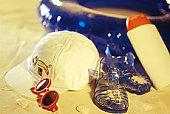
Sunshine, vitamin D, burning, cancer prevention, sunscreens, suncreams, oestrogen mimics and retinyl palmitate. Now there’s a title!
 Do sunscreens really prevent cancer? Or could some be making matters worse?
Do sunscreens really prevent cancer? Or could some be making matters worse?
It’s that time of year. You know, when that famous Health Journal, The Daily Mail, aided and abetted by a coterie of cancer ’experts’ and cancer charities warn you to keep out of the sun. And if you are going to bare all, make sure you ’slip, slap, slop’ or whatever the adman’s slogan is this year.
Well, I for one would liker you to know that I consider this nonsense all ’alarmist drivel’. Indeed this nave advice may even be causing more cancers than it supposedly prevents. Because of the mis-information of the last ten years, we have launched the CANCERactive SafeSun campaign, unencumbered by politics or vested interests, it is designed to help you get the most out of your sunshine! (Click here to go to Practise SafeSun.)
The role of oestrogen
Research is extremely clear that melanoma is usually an oestrogen-driven cancer. (Oestrogen is the female sex hormone and lies behind many cancers, even in men).
Not all skin cancers are melanoma. The majority are much less severe but the research is quite clear on general skin cancers too. People who develop these relatively harmless cancers go on to get much higher rates of other cancers later in life. Again, oestrogen seems to lie behind this.
Oestrogen mimics, xeno-estrogen chemicals
Several research studies have linked increased oestrogen levels to greater risk of skin cancer - in one study a lady on the contraceptive pill was deemed to have twice the risk of skin cancer as her identical twin who didn’t take it.
Also localised oestrogen seems to stimulate the skin and makes it more sensitive to genetic change. Many sunscreens contain chemicals that are oestrogen mimics and so could be making the cancer risk worse, not reducing it. (A number of chemicals in common personal care products, once inside the body, act like oestrogen and are called oestrogen mimics or xeno-estrogens). Indeed the oestrogen mimic could simply come from the plasticiser used in making the plastic bottle! And there is research from Johns Hopkins Medical School in America that leaving a plastic bottle in the sun can cause the plasticisers in the bottle to denature producing more oestrogen mimic chemicals in the liquid contained!
However, in my review of some of the ’top UK cancer web sites’ I cannot find any mention of research about oestrogen mimics and the potential risks of sunscreens if they contain them. One might wonder how much of a co-incidence it is, that some of the very companies who work with these august cancer bodies to develop cancer drugs are the same companies producing sunscreens containing known oestrogen mimics.
Telling people to whack on some sun screen could be doing more harm than good.
Questioning Retinyl Palmitate

But sunscreen risk is not just confined to possible oestrogen-mimics. There is now a growing and strong body of evidence against a very common ingredient retinyl palmitate, a compound close to vitamin A. Take the new research and warnings from no less an authority than America’s Environmental Working Group (a non-profit making public health group). Their research indicated that more than half of US sunscreens may actually increase the speed at which malignant cells develop and spread skin cancer. Although their research was ’only conducted on mice’, this is not new news and is just the most recent piece of research in a long line of studies expressing concern and experts are attacking the FDA for dragging its heels in coming to a decision. The EWG report announced a potential link between skin cancer and vitamin A, which is added to thousands of skin care products such as sunscreens, lotions, and a variety of moisturisers and skin conditioners for its antioxidant capabilities in slowing skin aging.
Dr. Marta Rendon, a board-certified dermatologist and global spokesperson for Procter & Gamble’s Head and Shoulders division acknowledged to the media that past studies have shown some evidence that vitamin A can exhibit some phototoxicity.
The FDA are now sitting on a number of studies suggesting that when retinyl palmitate is applied to the skin and exposed to sunlight it may become increase toxicity and carcinogenic reaction.
So the very ingredient used in sunscreens to help protect the skin from harmful UV rays may actually be the cause of severe and even life-threatening skin damage. Worse the report also states that the link between retinyl palmitate and skin cancer may have been suppressed because so many large skin care companies are using the ingredient in popular and lucrative topical skin care products.

Essential Vitamin D
It should not be forgotten that sunshine produces vitamin D by the action of sunlight on the cholesterol layers below the skin. Vitamin D now has a clear and strong body of evidence supporting its role both in cancer prevention and as an active agent against cancer if you have it. This is virtually not covered at all in the supposed top UK cancer web sites. Except for the unique CANCERactive charity site, that is!
There is even research (about a dozen studies that I know of) that shows that people who live in the sunniest climates get far less cancers! And more studies showing that ridiculous warnings to keep out of the sun are causing blood levels of vitamin D to decline and even the return of Rickets!
Unfortunately American press comment on this latest retinyl palmitate study has been quick to take a shot at vitamin A and tell people to ’use sunscreens containing titanium and zinc oxide, to apply a shot glass of sunscreen at a time and reapply every two hours and to wear hats, sun-protective clothing and even to stay out of the sun’. It’s the usual drivel. Remember:
Sunshine is sensational; burning is bad, sunscreens can be severe. PRACTISE SAFESUN.
See also: 15 ways to save your skin (Click here)

Click here to learn more about our campaign.